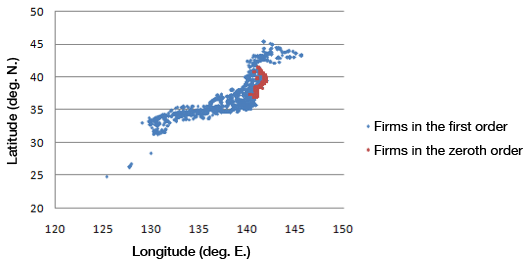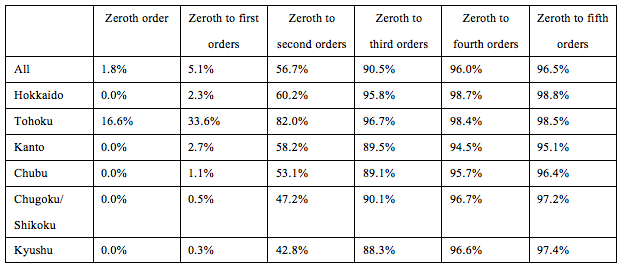The March 2011 quake and tsunami, a once-in-a-millennium disaster, served as a sobering reminder for Japanese companies, including many of those located away from the affected area, of the importance of having a clear picture of their supply chain structures. During ordinary times, they would rarely think beyond their direct transaction partners—i.e., transaction partners' transaction partners, their transaction partners, etc.—in developing business and management strategies. It has been long perceived that the competitiveness of Japanese industries stems from the strong linkages between transaction partners. However, this sort of competitiveness is now considered vulnerable to linkage-cutting phenomena such as earthquakes. It is about time to consider long-term measures to encourage companies to build transaction networks that are more stable and resilient.
Magnitude of the quake damage
Many companies in the affected area are physically unable to carry out production activities with their facilities destroyed by the quake and tsunami. Defining 44 municipalities located along the Pacific Ocean in Aomori, Iwate, Miyagi, and Fukushima Prefectures as the disaster-stricken area, Tokyo Shoko Research, Ltd. (TSR), a major credit research firm, has analyzed the number of companies, their sales figures, and the number of employees to measure the magnitude of the quake damage, compiling the findings as a survey report on the Great East Japan Earthquake. (Note 1) The analysis shows there were 32,341 companies with a total of 363,796 employees. However, in order to measure the true magnitude of the quake damage, it is necessary to consider the impact inflicted not only on the companies within the affected area but also on those located outside. For instance, suppose that a company, located in a non-affected area, has a supplier in the affected area. If the supplier is unable to continue production activities, the company needs to find a replacement. In the case where the original supplier is not easily substitutable, for instance, because the supply production requires special technology, the company will also be unable to continue its production activities. That is, a disruption in the operations of a supplier in a disaster-stricken area could deal a fatal blow to its client company. Meanwhile, a company with customers in a disaster-affected area would have to find new ones for its products.
As such, it is presumed that many companies, although located outside the disaster-affected area, are suffering significant damage because their transaction partners are located there. Furthermore, companies may be suffering quake damage unknowingly, for instance, because their transaction partners' suppliers or clients are located in the disaster-affected area.
Supply chain structure
An important viewpoint in analyzing the magnitude of the quake damage that spreads through inter-firm transactional relationships is to focus on the structure of inter-firm transaction networks. This is due to the proportion of affected companies differing greatly depending on the differences in network structures.
For instance, as summed up by an oft-quoted phrase, "everyone in the world is connected to everyone else through six degrees of separation," the presence of a small-world network structure is well-known in the field of sociology. If such structure is found in inter-firm transaction networks, it will imply that an extremely large number of companies in non-disaster-affected areas suffer quake damage through supply chains.
In order to capture the picture of inter-firm transactional relationships, it is necessary to obtain firm-level data on transactional relationships. In this regard, TSR's dataset contains data on approximately four million transactional relationships of approximately 800,000 firms. Utilizing these extensive data, Saito, Watanae and Iwanuma (2007) has shown that inter-firm networks have a scale-free structure in which a small number of hub firms occupy a large proportion of transactional relationships, whereas Ohnishi, Takayasu and Takayasu (2010) has demonstrated the presence of the small-world network structure.
Impact on companies in non-affected areas
The fact that inter-firm transaction networks have small-world characteristics suggests that an extremely large number of companies suffer quake damage through supply chains even in the unaffected areas. Then, how do they spread geographically? The figure below illustrates the geographical spread of firms in the affected areas (shown in red dots) and their transaction partners (shown in blue dots). Firms in the zeroth order are those in the disaster-affected areas and those in the first order stand for their transaction partners in the figure below.
Existing studies have empirically shown that inter-firm transaction relationships are predominantly localized with half of the surveyed relationships falling within a physical distance of 40km or less and approximately 90% within 400km (Nakajima, Saito and Uesugi (2012)). Meanwhile, the figure below shows that firms that are transaction partners of those in the affected areas are geographically widespread. As discussed later, however, they represent a very small proportion of total firms, which is consistent with what has been suggested by existing studies.
The table below shows that the proportion of firms in the affected areas (zeroth order), their transaction partners (first order), such transaction partners' transaction partners (second order), and so forth are relative to the total number of firms by region. As discussed above, the proportion of firms that are transaction partners of those in the affected areas is very small, accounting for 2.3% of total firms in Hokkaido, 2.7% in Kanto, 1.1% in Chubu, and 0.5% or less in Chugoku/Shikoku and Kyushu. However, the figures increase to 60% in Hokkaido, 58% in Kanto, 53% in Chubu, and 40% or more in Chugoku/Shikoku and Kyushu if those in the second order are included, indicating that a large number of firms are indirectly related with those in the affected areas. Furthermore, expanding the scope to include those in the third order will raise these figures to nearly 90% in all regions, meaning that most firms in Japan have some sort of relationships with those in the affected areas.
Based on the above analysis, we can see that a vast majority of the firms located in the unaffected areas may actually be affected unknowingly through their transactional relationships. The magnitude of the impact on specific firms is determined by the substitutability of suppliers in the affected areas, the degree of dependence on a single customer, and the strength of inter-firm linkages. It has long been considered that Japan's industrial competitiveness hinges on strong connections linking companies with their transaction partners. However, such competitiveness would be vulnerable to linkage-cutting phenomena such as earthquakes.
It is believed that a major earthquake may hit the Tokai region in the not-so-distant future. The vulnerability to earthquakes stems from the small-world network structure and the strong inter-firm linkages. In order to encourage Japanese companies to build more stable and resilient transaction networks, the government should implement long-term measures to promote risk dispersion, for instance, by developing and maintaining a geographically diversified portfolio of transaction partners.




